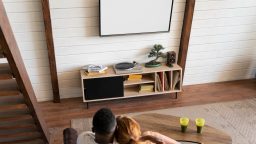As more people shift to remote work, having a well-organised and functional home office has become essential. Whether you’re working from home full-time, part-time, or just need a space to handle occasional tasks, creating a dedicated office area can help boost productivity and maintain a healthy work-life balance. This guide will provide practical tips on how to create a functional home office that promotes focus, comfort, and efficiency.
- Choose the Right Location
The first step in creating a home office is selecting the right location. Ideally, your workspace should be separate from the distractions of daily life. If you have a spare room, this is an ideal choice for a dedicated office. However, if you don’t have a separate room, find a quiet corner or nook in your home, such as under the stairs, a section of your living room, or a portion of your bedroom. The key is to choose a spot that allows you to focus and minimizes distractions.
Try to avoid setting up your office in high-traffic areas or near distractions like the TV, kitchen, or areas with heavy foot traffic. If space is limited, consider creating a multi-functional space where your office setup is easy to set up and put away when not in use.
- Invest in Ergonomic Furniture
When creating a functional home office, comfort is key. Since you’ll likely be spending hours at your desk, investing in ergonomic furniture is a must. Start with a comfortable office chair that provides support for your back, neck, and arms. Look for a chair with adjustable height, armrests, and lumbar support to ensure that you can sit comfortably for long periods of time.
A spacious desk is equally important. Choose a desk that fits your needs, whether you prefer a minimalist design with just enough space for a computer or something larger to accommodate a computer, documents, and other work materials. Consider desks with built-in storage to reduce clutter and keep your space organised.
- Optimise Your Lighting
Proper lighting is crucial for both productivity and eye comfort. A well-lit workspace reduces eye strain and creates a more inviting environment. Start by ensuring that your home office gets plenty of natural light. Position your desk near a window if possible, but avoid placing it directly in front of or behind the window to prevent glare on your screen.
In addition to natural light, make sure to incorporate task lighting, such as a desk lamp with adjustable brightness, to illuminate your workspace. A well-placed lamp will help brighten your desk without straining your eyes. Consider using LED lights for energy efficiency, and opt for warmer light bulbs to create a calming atmosphere.
- Keep Your Space Organised
Clutter can be a major productivity killer, so it’s important to keep your office space organised. Use storage solutions like filing cabinets, shelves, and desk organisers to keep your documents and office supplies tidy. Vertical storage is especially useful for smaller spaces, as it helps maximise floor space and keeps your items easily accessible.
Consider using drawer organisers to separate items like pens, paper clips, and post-it notes, so you can find what you need quickly. A well-organised workspace also makes it easier to maintain a clear mind, so you can stay focused on your tasks.
- Set Up Technology and Equipment
Having the right technology in place is essential for a functional home office. At a minimum, you’ll need a reliable computer, high-speed internet connection, and a good quality printer. Make sure that your computer is up to date and has the necessary software for your work.
If you spend a lot of time on video calls, invest in a good webcam, microphone, and possibly a ring light to ensure you look and sound your best during meetings. Additionally, consider a wireless keyboard and mouse for a cleaner setup and to reduce cable clutter.
Don’t forget about cable management! Use cable clips, organisers, or a cable management box to keep your cords tidy and out of sight. This not only improves the aesthetic of your space but also prevents tangling and tripping hazards.
- Personalise Your Workspace
A personal touch can help make your home office feel more inviting and inspiring. Add items that motivate you or bring you joy, like framed photos, artwork, or plants. Greenery can improve air quality and bring a calming, nature-inspired vibe to your workspace. If space allows, consider placing a small indoor plant, like a succulent or snake plant, on your desk or a shelf.
Be mindful of the items you add to your workspace. While personalisation is important, it’s also essential to avoid overcrowding the space. Choose meaningful decor that enhances the atmosphere without contributing to clutter.
- Create a Comfortable Work Environment
In addition to ergonomic furniture and good lighting, your work environment should promote focus and comfort. Consider the room’s temperature, air quality, and noise level. If your office tends to get stuffy, consider investing in a small fan or air purifier to improve air circulation. On the other hand, if it’s too cold, a space heater or a blanket can make your workspace more comfortable.
For those who are sensitive to noise, noise-cancelling headphones or a white noise machine can help reduce distractions and allow you to focus better. Additionally, adding a rug to your office can help absorb sound and make the room feel cozier.
- Establish Boundaries
If you work from home, it’s important to establish boundaries between your work life and personal life. One of the challenges of working remotely is the temptation to keep working after hours or becoming easily distracted by household tasks. To combat this, set clear boundaries for when your workday begins and ends.
Create a designated „work mode” in your office that signals when you’re in work mode and when you’re not. This could involve shutting the door, clearing your desk, or turning off your computer at the end of the day. Establishing these boundaries helps maintain a healthy work-life balance and allows you to focus better when you’re working.
- Set a Daily Routine
A consistent routine can help you stay productive and maintain a work-life balance. Start by setting regular work hours, creating a daily schedule, and planning breaks throughout the day. A structured routine can help reduce procrastination and ensure that you’re accomplishing tasks efficiently.
Consider using a task management tool or a simple to-do list to keep track of your daily and weekly goals. This will help you stay organised and ensure that you’re staying on top of your tasks without feeling overwhelmed.
- Stay Flexible
While having a functional home office is key, remember that your needs may change over time. As you gain experience working from home, you may discover new tools, layouts, or habits that improve your productivity and comfort. Stay open to adjusting your space as you go, whether that’s reorganising furniture, updating technology, or experimenting with different work routines.
Conclusion
Creating a functional home office involves thoughtful planning, the right furniture, and a personalised environment that supports both your comfort and productivity. By selecting a quiet location, investing in ergonomic furniture, and organising your space effectively, you can create a workspace that promotes focus, efficiency, and well-being. Whether you’re working from home full-time or just need a quiet space to catch up on tasks, these tips will help you set up a home office that works for you. Happy working!





